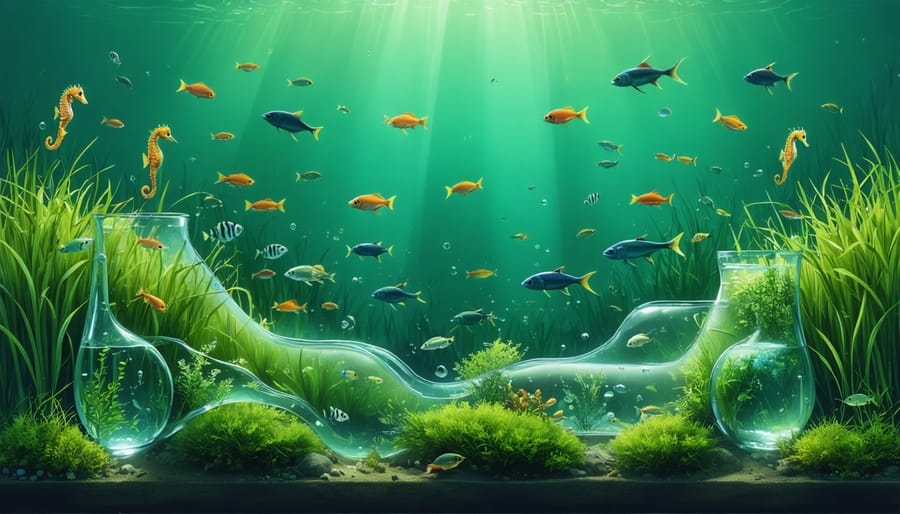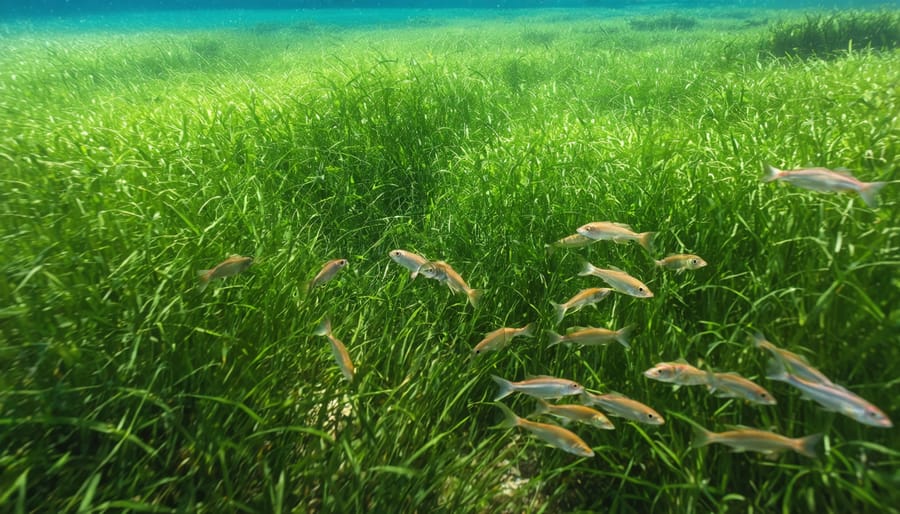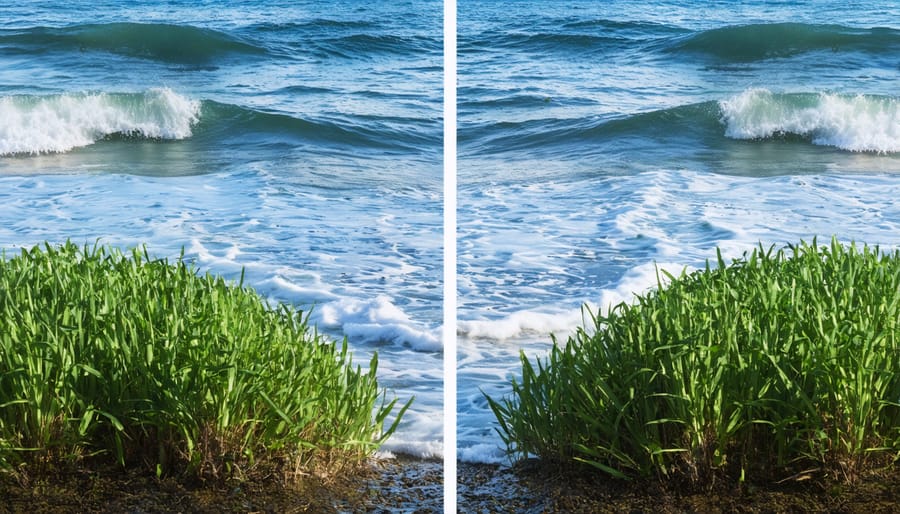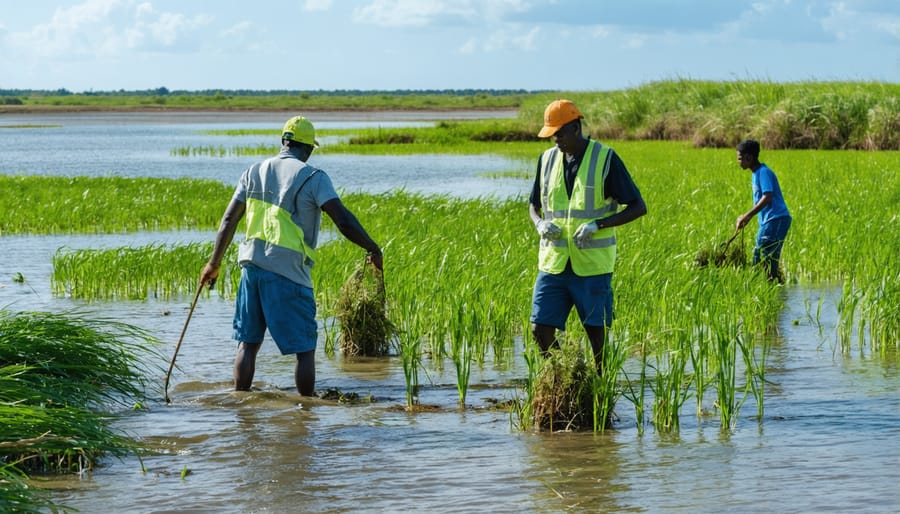
The Hidden Powerhouse of Marine Ecosystems

Nature’s Carbon Champion
Seagrass meadows are nature’s unsung heroes in the fight against climate change, boasting remarkable carbon sequestration abilities that surpass those of terrestrial forests. These underwater gardens can capture carbon dioxide up to 35 times faster than tropical rainforests, storing it within their extensive root systems and in the sediment below for thousands of years.
What makes seagrass particularly efficient is its dual-action approach to carbon storage. The plants themselves absorb CO2 through photosynthesis, while their dense root networks trap additional organic matter in the seafloor, creating what scientists call “carbon sinks.” A single hectare of seagrass can store up to 400 kilograms of carbon per year, equivalent to the emissions from four cars.
Moreover, seagrass meadows maintain their stored carbon for exceptionally long periods. Unlike terrestrial forests that release carbon when burned, seagrass deposits remain safely locked away in marine sediments, provided these ecosystems remain undisturbed. This long-term storage capability makes seagrass preservation crucial in our global strategy to combat rising atmospheric CO2 levels.
Marine Life’s Perfect Nursery
Seagrass meadows serve as nature’s most perfect nursery, providing essential shelter and nourishment for countless marine species during their most vulnerable life stages. These underwater forests create intricate networks of leaves and roots that offer excellent hiding spots for juvenile fish, protecting them from predators while they develop into adults. The dense vegetation also supports remarkable marine biodiversity, hosting everything from tiny seahorses to baby sharks.
The nursery role of seagrass extends beyond just providing shelter. These meadows produce oxygen-rich environments and maintain stable water temperatures, creating ideal conditions for eggs to develop and young marine life to thrive. Small fish find abundant food sources among the grass blades, feeding on the rich variety of organisms that make their home in these underwater gardens.
Studies have shown that seagrass meadows support up to 40 times more marine life than adjacent bare sandy areas. This makes them invaluable for maintaining healthy fish populations, including many commercially important species that humans rely on for food security. The protection these areas provide is so crucial that many marine species time their breeding seasons to coincide with peak seagrass growth periods.
Essential Services Seagrass Provides
Coastal Protection Warriors
Along coastlines worldwide, seagrass meadows act as natural defense systems, earning them the title of nature’s coastal protection warriors. These underwater gardens create dense networks of roots and rhizomes that bind sediments together, effectively preventing coastal erosion that threatens shorelines and communities.
During storms and extreme weather events, seagrass beds demonstrate remarkable resilience by absorbing wave energy and reducing water velocity. This natural buffer can decrease wave height by up to 40%, protecting coastal infrastructure and communities from the full force of storm surges. The plant’s flexible leaves sway with water movement, dissipating energy while maintaining their protective structure.
Beyond storm protection, seagrass meadows trap and stabilize sediments, helping to maintain shoreline integrity and prevent beach erosion. This process is particularly crucial in areas facing rising sea levels and increased storm frequency due to climate change. The sediment-trapping capability of seagrass also helps maintain water clarity, creating a positive feedback loop that supports the continued growth and survival of these protective marine meadows.
Marine scientists have observed that coastlines with healthy seagrass ecosystems show significantly less erosion and storm damage compared to unprotected shores, highlighting their vital role in coastal defense strategies.

Water Quality Guardians
Seagrass meadows serve as nature’s water filtration systems, acting as tireless guardians of marine water quality. Through their dense network of leaves and roots, these underwater plants excel at filtering pollutants from coastal waters, including excess nutrients, suspended particles, and even bacterial contaminants.
Like living sieves, seagrass beds trap fine sediments that would otherwise cloud the water, allowing sunlight to penetrate deeper into marine ecosystems. This natural clarifying process is crucial for the survival of countless marine species that depend on clear waters for hunting, breeding, and navigation.
Research has shown that a single acre of seagrass can filter millions of gallons of water annually, removing nitrogen and phosphorus that could otherwise fuel harmful algal blooms. Their root systems also stabilize seafloor sediments, preventing erosion and maintaining water clarity even during storms.
Marine biologists have observed that areas with healthy seagrass populations consistently show better water quality metrics compared to areas where seagrass has been lost, highlighting their irreplaceable role in maintaining clean, healthy marine environments.
Food Security Heroes
Seagrass meadows serve as crucial nurseries and feeding grounds for numerous commercially important fish species, directly supporting the livelihoods of millions of small-scale fishers worldwide. In coastal communities from Southeast Asia to East Africa, these underwater gardens provide essential habitat for fish species like snappers, groupers, and shellfish that local fishers depend on for their daily catch.
Consider the story of Ahmad, a third-generation fisher from Indonesia’s Coral Triangle, who has witnessed firsthand how healthy seagrass meadows contribute to abundant fish populations. “When seagrass is healthy, our nets are full,” he often says, highlighting the direct connection between marine habitat conservation and food security.
Studies have shown that seagrass meadows can support up to 40 times more marine life than adjacent bare sandy areas. This impressive biodiversity translates into reliable income for coastal communities, with estimates suggesting that one hectare of healthy seagrass can support the livelihoods of up to fifteen fishing families.
Beyond commercial fishing, seagrass meadows also support traditional subsistence fishing practices, particularly in developing nations where communities rely on marine resources for daily protein intake. In many regions, women and children participate in gleaning activities during low tide, collecting shellfish and small fish from seagrass beds, contributing significantly to household food security and nutrition.
Threats and Conservation Challenges
Human-Induced Pressures
Seagrass meadows face mounting pressures from human activities, with coastal development emerging as one of the most significant threats. As coastal populations grow, construction projects, shoreline modifications, and dredging activities directly destroy seagrass habitats and increase water turbidity, reducing the light essential for seagrass photosynthesis.
Pollution poses another critical challenge to seagrass survival. Agricultural runoff rich in nutrients leads to algal blooms that block sunlight and deplete oxygen levels in coastal waters. Urban wastewater discharge introduces harmful chemicals and excess nutrients, while plastic pollution entangles seagrass blades and affects marine life dependent on these ecosystems.
Boat traffic also takes a substantial toll on seagrass beds. Propeller scarring from vessels traveling through shallow waters can take years to heal, creating long-lasting damage to these delicate ecosystems. Anchor damage compounds this issue, as heavy anchors and chains can uproot large patches of seagrass.
Climate change amplifies these pressures through rising sea temperatures and ocean acidification, making it harder for seagrass to thrive and recover from other environmental stresses. The combination of these factors has led to a global decline in seagrass coverage, with some regions losing up to 7% of their seagrass meadows annually. This loss significantly impacts marine biodiversity and coastal communities that depend on healthy seagrass ecosystems for their livelihoods.
Climate Change Impacts
Seagrass meadows face unprecedented challenges as our oceans warm and change. The climate change impacts on these vital ecosystems are becoming increasingly evident, with rising sea temperatures and ocean acidification posing significant threats to their survival.
As global temperatures rise, seagrass meadows experience thermal stress, leading to reduced growth rates and increased mortality. When water temperatures exceed their thermal tolerance, entire meadows can experience die-offs, leaving once-thriving ecosystems barren. Ocean acidification, another consequence of rising CO2 levels, affects the ability of many marine organisms to build their calcium carbonate shells, disrupting the delicate balance of species that depend on seagrass habitats.
Sea level rise presents another challenge, as deeper water reduces the amount of sunlight reaching seagrass beds. Without adequate light, these plants cannot photosynthesize effectively, leading to decreased productivity and potential habitat loss. Extreme weather events, which are becoming more frequent and intense, can physically damage or uproot seagrass beds, particularly in shallow coastal areas.
However, there’s hope. Seagrass meadows demonstrate remarkable resilience when given the chance to recover. By reducing local stressors such as water pollution and physical damage from boats, we can help these ecosystems better withstand climate-related pressures. Scientists and conservationists are working together to identify and protect climate-resilient seagrass populations, which may hold the key to adaptation in a warming world.
Taking Action: What We Can Do
Community-Led Conservation
Across the globe, communities are taking action to protect and restore their local seagrass meadows, demonstrating the power of collective effort in marine conservation. Project Seagrass in the United Kingdom has successfully engaged thousands of volunteers in mapping, monitoring, and replanting efforts, resulting in the restoration of over 30 hectares of seagrass beds along the Welsh coastline.
In the Philippines, local fishing communities have established marine protected areas specifically for seagrass conservation, combining traditional knowledge with scientific practices. Their efforts have led to a 40% increase in local fish populations and improved livelihoods for coastal communities.
Volunteers can participate in various activities, from citizen science programs that monitor seagrass health to hands-on restoration work. Organizations like SeagrassWatch provide training for volunteers to collect valuable data on seagrass coverage and species diversity. In Florida, the “Seagrass Guardian” program enables recreational boaters to report seagrass damage and participate in education initiatives.
These community-led projects often incorporate innovative approaches, such as using underwater GoPro cameras for monitoring and deploying seed dispersal units designed by local engineering students. The success of these initiatives proves that when communities unite for conservation, remarkable results are possible. Getting involved is as simple as contacting local marine conservation organizations or joining online networks dedicated to seagrass preservation.

Individual Impact
Individual actions play a crucial role in protecting seagrass ecosystems, and there are numerous ways people can contribute to their conservation. Boaters can practice responsible anchoring by avoiding seagrass beds or using mooring buoys when available. When walking or wading in shallow waters, staying in marked channels helps prevent damage to these delicate marine plants.
Reducing household pollution is another significant way to protect seagrass. Using eco-friendly cleaning products, properly disposing of chemicals, and maintaining septic systems help prevent harmful runoff from reaching coastal waters. Garden enthusiasts can choose organic fertilizers and create rain gardens to filter stormwater before it reaches the ocean.
Volunteering for seagrass monitoring programs offers hands-on involvement in conservation efforts. Many coastal organizations welcome citizen scientists to help map seagrass beds, collect data, and participate in restoration projects. Education plays a vital role too – sharing knowledge about seagrass importance with friends, family, and community members helps build broader support for conservation initiatives.
Supporting local conservation organizations through donations or membership contributes to scientific research and protection efforts. Participating in beach cleanups removes debris that might otherwise damage seagrass beds. Even making sustainable seafood choices helps, as it promotes fishing practices that don’t harm seagrass habitats.
By combining these individual actions with community engagement, everyone can contribute to preserving these essential marine ecosystems for future generations.
The time to act for seagrass conservation is now. As our understanding of these vital marine ecosystems deepens, so does the urgency to protect them. The cascading effects of seagrass loss – from diminished fish populations to increased coastal erosion and reduced carbon sequestration – threaten not just marine biodiversity but human communities worldwide.
Yet there is hope. Successful seagrass restoration projects around the globe demonstrate that recovery is possible when communities, scientists, and policymakers work together. From volunteer-led monitoring programs to community-based restoration initiatives, individuals everywhere are making a difference. Marine biologist Dr. Sarah Chen shares, “I’ve witnessed firsthand how a small group of dedicated volunteers can transform a degraded seagrass meadow into a thriving ecosystem within just a few years.”
You can be part of this vital conservation effort. Consider joining local marine conservation groups, supporting research initiatives, or participating in citizen science projects. Simple actions like reducing water pollution, practicing responsible boating, and spreading awareness about seagrass importance can create meaningful impact.
Remember, seagrass meadows are more than just underwater plants – they are the foundation of healthy oceans and resilient coastal communities. By protecting these essential ecosystems today, we safeguard marine biodiversity and ensure a sustainable future for generations to come. The choice to act is ours, and the time is now.
jessica
Ava Singh is an environmental writer and marine sustainability advocate with a deep commitment to protecting the world's oceans and coastal communities. With a background in environmental policy and a passion for storytelling, Ava brings complex topics to life through clear, engaging content that educates and empowers readers. At the Marine Biodiversity & Sustainability Learning Center, Ava focuses on sharing impactful stories about community engagement, policy innovations, and conservation strategies. Her writing bridges the gap between science and the public, encouraging people to take part in preserving marine biodiversity. When she’s not writing, Ava collaborates with local initiatives to promote eco-conscious living and sustainable development, ensuring her work makes a difference both on the page and in the real world.
